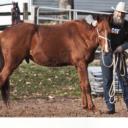Yahoo Answers is shutting down on May 4th, 2021 (Eastern Time) and beginning April 20th, 2021 (Eastern Time) the Yahoo Answers website will be in read-only mode. There will be no changes to other Yahoo properties or services, or your Yahoo account. You can find more information about the Yahoo Answers shutdown and how to download your data on this help page.
Trending News
Can someone tell me about gag bits?
Yesterday I was talking to this women at my barn about different bits to try on my horse, and she recommend something like her daughters draw gag. And I was interested in them, but I'm trying to look them up and can't find a lot of solid information.
Thanks.
7 Answers
- Anonymous9 years agoFavorite Answer
How a gag bit works, there is a bit in the horses mouth, i have usually seen them to be snaffels, and then there is a pully mechanism that attaches tot he reins so when you pull on the reins it will pull the bit farther up in to the horses mouth and pull at the mouth corners in essence looking like it gags him. the harder you pull the harder the bit is drawn up in to the horses mouth. They are pretty gruesome bits and are unnecessary if the horse is taught to properly yield tot he bit. you will have a better horse in the long run if you go back to square one and teach a basic one rein stop.
- 9 years ago
As most people have said, they are not really something you want to ride with on a regular basis. The horse has a very sensitive mouth, and a strong bit will generally cause him to be more stressed out and worry more, making your problems worse, not better. A strong bit almost never fixes a problem. The only time I have ever used a gag bit was for a couple weeks of trail riding with a haflinger pony who insisted he needed to drag the reins out of my hands ever couple of feed to eat grass. I used it as a correction too for when he was insistent on dragging me around, not listening to a softer touch. After a short time in the gag, it was no longer needed, doing it's job to break the pulling habit and then he went back into a mild snaffle. If you don't know about the bit or for what purpose you would be using it, then it's not something you need to put in your horse's mouth.
If your horse is leaning on the bit, send him forward, do some half halts to help lighten his front end, and don't give him anything to brace on with your hands and arms- this doesn't mean throw away contact with loopy reins, but don't allow him to sucker you into holding his head up. A few squeezes and releases on both reins will generally achieve this.
Source(s): certified riding instructor. - 9 years ago
The gag bit is a type of bit for a horse. With two sets of reins, the gag bit gives a rider the ability to use either a standard direct action or a gag action. In this, the gag bit is related to a Pelham bit and a double bridle. Unlike these, however, the gag bit has no curb strap. The gag bit works on the horse's lips and poll simultaneously. The pressure on the lips tends to make the horse raise its head, which is useful for a horse that tends to lean on the bit. Gag bits are used mainly for horses that are strong pullers or for horses that need retraining. Gag bits are most commonly seen in polo, eventing (especially for cross-country), show jumping, and hacking, mainly for increased control at times where a horse may be excited or try to run off with the rider.
Source(s): Wikipedia - 9 years ago
Not quite sure why you would want a gag bit. I've always used a loose, D ring snaffle bit unless I'm showing.
Does your horse have a tough mouth? If not I wouldn't put a gag bit on. It wouldn't take much pressure to hurt his/her mouth.
If you have a trainer I'd ask their opinion.
Source(s): Had horses for 40 years - How do you think about the answers? You can sign in to vote the answer.
- Becky S.Lv 69 years ago
What issues is your horse having?
A gag bit is a pretty strong bit. With a bit like that, I would imagine your horse is very, very fine tuned and you barely need to touch the reins to get your request across.
- zakiitLv 79 years ago
They are extremely severe in the wrong hands. You need to have very steady and independent hands, which are gentle and giving. If you put a stronger bit in a horse;s mouth, it can lead to further problems if you are not careful.
It puts an awful lot of pressure on the tongue and bars of the mouth, and also on the poll.
If you are having braking problems, then I suggest that you get a few lessons to determine what the problem might be. He could be heavy on his forehand, you might be (unintentionally) rough with your hands, or not riding properly with your seat. Also get his mouth, teeth and gums checked by an equine dentist. Rough edges, the wrong sized bit etc, could all be causing problems.
Source(s): Riding instructor




